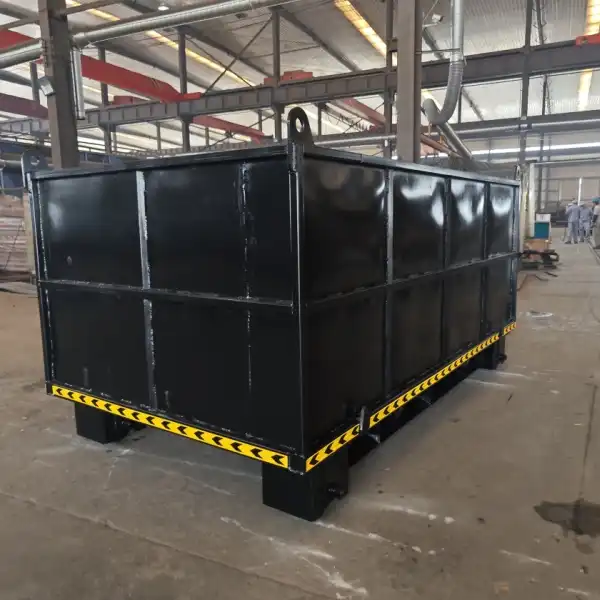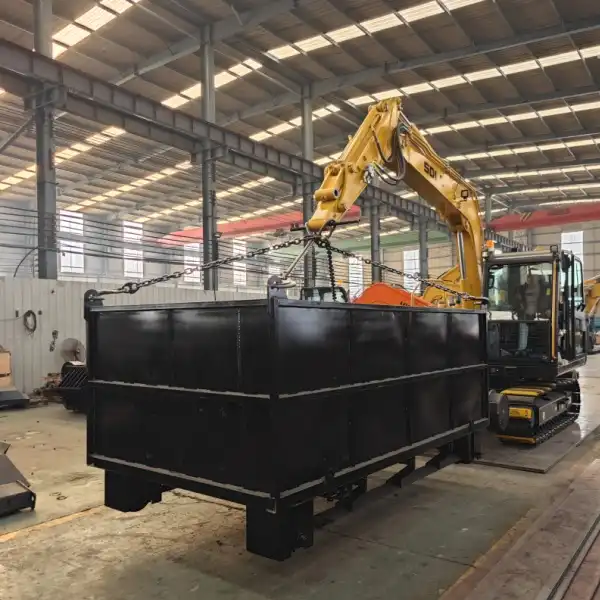How to replace railway ballast cars?
Replacing railway ballast cars is a critical maintenance operation that requires careful planning, proper equipment, and adherence to safety protocols. The process involves systematically removing worn or damaged railroad ballast car units and installing new ones to maintain optimal track stability and drainage. This comprehensive replacement procedure typically spans several phases, beginning with thorough assessment of existing equipment conditions and ending with complete system integration testing. Understanding the intricacies of ballast car replacement ensures railway operators can maintain safe, efficient transportation networks while minimizing downtime and operational disruptions.

Pre-Replacement Planning and Assessment
Successful railroad ballast car replacement begins long before any physical work commences on the railway. The planning phase establishes the foundation for smooth operations and helps prevent costly delays or safety incidents during the actual replacement process. This critical stage determines project success and operational efficiency throughout the entire replacement cycle.
Comprehensive Equipment Evaluation
The initial step involves conducting thorough inspections of existing ballast cars to determine replacement priorities. Railway maintenance teams examine structural integrity, hydraulic systems, and overall mechanical condition to create detailed replacement schedules. This evaluation process helps identify which units require immediate attention versus those that can continue operating until planned maintenance windows.
Engineering assessments should include detailed documentation of current railroad ballast car specifications, capacity requirements, and operational parameters. Teams must also consider track gauge compatibility, loading height restrictions, and coupling systems to ensure new equipment integrates seamlessly with existing railway infrastructure. Comprehensive evaluations examine frame integrity, hydraulic cylinder functionality, valve performance, and structural wear patterns that might indicate imminent failure.
Professional inspection teams utilize specialized diagnostic equipment to assess hidden damage or wear that might not be visible during routine visual inspections. Ultrasonic testing reveals internal structural weaknesses, while hydraulic system pressure tests identify potential failure points before they become critical operational issues. This proactive approach prevents unexpected equipment failures that could disrupt railway operations or compromise worker safety.
Resource Allocation and Scheduling
Effective resource management requires coordinating multiple elements simultaneously. Project managers must secure appropriate crane equipment, transportation vehicles, and skilled personnel while establishing realistic timelines for each phase of the replacement operation. Resource allocation encompasses both human resources and specialized equipment necessary for safe, efficient ballast car replacement.
Railway operators typically schedule ballast car replacements during low-traffic periods to minimize service disruptions. This scheduling consideration becomes particularly important for busy freight corridors or passenger lines where extended track closures can significantly impact operations and revenue. Coordination with traffic control centers ensures replacement activities align with broader network operational requirements.
Budget planning must account for equipment rental costs, specialized tooling requirements, transportation expenses, and potential overtime labor costs. Experienced project managers develop contingency budgets to address unexpected complications or extended project timelines that commonly arise during complex railway maintenance operations.
Removal of Old Ballast Cars
The removal phase represents the most physically demanding aspect of railroad ballast car replacement, requiring careful coordination between multiple teams and specialized equipment to ensure safe, efficient operations. This phase demands meticulous attention to detail and systematic approach to prevent damage to surrounding infrastructure or remaining equipment.
Site Preparation and Equipment Positioning
Before beginning removal operations, teams must establish secure work zones with appropriate barriers and warning systems. Mobile cranes and heavy-lift equipment require stable positioning on level ground with adequate clearance for safe operation around railway infrastructure. Site preparation includes establishing temporary access roads, utility disconnections, and environmental protection measures.
Track isolation procedures ensure complete electrical disconnection and mechanical separation from active railway systems. This isolation process includes installing protective barriers, posting warning signs, and implementing lockout procedures to prevent accidental equipment activation during removal operations. Proper isolation protects both workers and equipment from electrical hazards or unexpected equipment movement.
Ground conditions require careful evaluation to ensure adequate support for heavy lifting equipment. Soft or unstable soil conditions might require temporary reinforcement or specialized crane mats to distribute equipment weight safely. Professional site supervisors assess ground conditions and implement appropriate stabilization measures before positioning heavy equipment.
Systematic Disconnection Process
Removing railroad ballast car units involves disconnecting multiple systems in specific sequences to prevent damage to remaining equipment. Hydraulic lines, electrical connections, and mechanical couplings require careful attention to avoid contamination or component damage during the disconnection process. Each disconnection step follows manufacturer specifications and industry best practices.
Experienced technicians follow manufacturer-specific procedures for each disconnection step, ensuring proper fluid drainage and component protection. Documentation of disconnection procedures helps streamline reconnection processes when installing replacement units. Proper documentation includes photographic records, component identification, and connection specifications for reference during installation phases.
Hydraulic system disconnection requires careful fluid recovery to prevent environmental contamination and preserve valuable hydraulic fluids for reuse. Specialized equipment captures and filters hydraulic fluids during disconnection procedures, reducing waste and environmental impact. Professional technicians verify complete system depressurization before beginning mechanical disconnection procedures.
Installation of New Ballast Cars
Installing replacement ballast cars requires meticulous attention to detail and systematic approach to ensure proper integration with existing railway systems and optimal long-term performance. The installation phase builds upon careful planning and preparation to deliver reliable, efficient ballast car operations for years of dependable service.
Equipment Delivery and Positioning
New railroad ballast car delivery requires coordination with manufacturers and transportation providers to ensure timely arrival at project sites. Teams must verify equipment specifications against project requirements and conduct thorough inspections before beginning installation procedures. Delivery coordination includes scheduling, route planning, and site preparation for receiving new equipment.
Positioning new equipment involves precise alignment with existing track systems and coupling mechanisms. Ground crews use survey equipment and alignment tools to ensure accurate placement within specified tolerances for optimal operational performance. Professional installation teams utilize laser alignment systems and precision measuring equipment to achieve exact positioning requirements.
Quality control inspections verify new equipment meets all specifications and performance requirements before installation begins. These inspections include dimensional verification, functional testing, and documentation review to ensure compliance with railway standards and project specifications. Any discrepancies must be resolved before proceeding with installation procedures.
System Integration and Connection
Connecting new ballast cars involves reverse procedures from the removal phase, with additional considerations for system compatibility and performance optimization. Hydraulic systems require proper fluid filling, pressure testing, and leak detection before operational approval. Professional technicians follow systematic procedures to ensure reliable system integration.
Electrical connections demand careful attention to circuit continuity, insulation integrity, and control system compatibility. Technicians perform comprehensive system checks to verify proper communication between new equipment and existing control systems. Advanced diagnostic equipment validates electrical system performance and identifies potential issues before operational deployment.
Mechanical connections require precise alignment and proper torque specifications to ensure reliable long-term performance. Professional installation crews utilize calibrated torque equipment and follow manufacturer specifications for all mechanical connections. Proper mechanical installation prevents premature wear and ensures optimal equipment performance throughout its service life.
Testing and Commissioning Procedures
Comprehensive testing protocols verify all systems function correctly before returning equipment to active service. These tests include hydraulic system performance, electrical circuit verification, and mechanical operation under various load conditions. Professional testing procedures follow established industry standards and manufacturer specifications.
Commissioning procedures involve gradually increasing operational loads while monitoring system performance indicators. This systematic approach helps identify potential issues before full operational deployment and ensures optimal railroad ballast car performance throughout its service life. Performance monitoring during commissioning phases provides baseline data for future maintenance planning.
Final acceptance testing demonstrates compliance with all performance specifications and operational requirements. Professional commissioning teams document all test results and verify equipment readiness for active railway service. Comprehensive documentation provides valuable reference information for future maintenance and operational planning.

FAQ
①How long does ballast car replacement typically take?
Complete replacement operations usually require 2-4 days per unit, depending on site conditions and equipment complexity. Planning phases can extend several weeks before physical replacement begins.
②What safety precautions are essential during replacement?
Key safety measures include proper track isolation, established work zones, qualified personnel, and emergency response procedures. All team members must complete railway safety training before participating in replacement operations.
③Can replacement operations occur during regular railway traffic?
Replacement operations typically require complete track isolation for safety reasons. Railway operators schedule these activities during planned maintenance windows or low-traffic periods to minimize service disruptions.
④What factors determine replacement timing?
Replacement timing depends on equipment condition assessments, operational requirements, budget considerations, and availability of maintenance windows. Proactive replacement prevents unexpected failures and service interruptions.
⑤How do you ensure new equipment compatibility?
Compatibility verification includes detailed specification review, dimensional analysis, and system integration testing. Professional engineering teams validate all compatibility factors before equipment procurement and installation.
Successful railway ballast car replacement requires careful planning, skilled execution, and comprehensive testing to ensure optimal performance and safety. The systematic approach outlined above helps railway operators maintain efficient, reliable transportation networks while minimizing operational disruptions. Professional maintenance teams understand that proper replacement procedures directly impact long-term system reliability and operational costs.
Whether you're planning routine fleet renewal or responding to emergency replacement needs, following established protocols ensures successful outcomes. The investment in proper replacement procedures pays dividends through improved system reliability, reduced maintenance costs, and enhanced operational safety throughout the equipment lifecycle. Modern ballast car technology offers enhanced performance capabilities that justify replacement investments through improved operational efficiency.
Professional railway maintenance requires specialized equipment designed for demanding operational environments. Quality ballast cars deliver reliable performance, efficient material distribution, and long service life that reduces total ownership costs. Proper equipment selection and professional installation ensure optimal return on replacement investments while maintaining high safety standards.
For railway operators seeking reliable ballast car solutions, Tiannuo offers high-quality railroad ballast car units designed for demanding operational environments. Our ballast cars feature 5.5m³ bucket capacity, 3300mm width, 1500mm height, and 1850mm depth construction using high-strength steel materials. The innovative leakage system enables efficient ballast distribution on both sides and bottom areas for optimal track maintenance operations. To learn more about our professional railway maintenance equipment solutions, contact our experienced team at raymiao@stnd-machinery.com.
References
- Railway Engineering and Maintenance Handbook: Best Practices for Ballast Car Operations, 4th Edition, International Railway Association, 2023.
- Heavy Equipment Replacement Protocols in Railway Infrastructure, Journal of Transportation Engineering, Volume 149, Issue 8, 2024.
- Safety Guidelines for Railway Maintenance Equipment Operations, Federal Railroad Administration Technical Manual, Revised 2024.
- Modern Railway Ballast Management Systems: Design, Operation, and Maintenance, Transportation Research Board Special Report 342, 2023.
- Cost-Effective Strategies for Railway Fleet Renewal and Equipment Replacement, Railway Gazette International Technical Papers, September 2024.
About Author: Arm
Arm is a leading expert in the field of specialized construction and railway maintenance equipment, working at Tiannuo Company. Tiannuo specializes in manufacturing a wide range of products, including railway maintenance equipment like railway sleeper changing machines and screening machines, excavator modification equipment such as excavator lifting cabs, various engineering arms for excavators, excavator accessories like digging buckets, and engineering vehicle auxiliary equipment like loader buckets.

